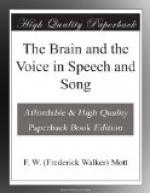[Description: FIG. 16.—Diagram of the left hemisphere of the brain showing localised centres, of which the functions are known. It will be observed that the centres for the special senses, tactile, muscular, hearing, and vision, are all situated behind the central fissure. The tactile-motor kinaesthetic sense occupies the whole of the post-central convolution; the centre for hearing (and in the left hemisphere memory of words) is shown at the end of the first temporal convolution, but the portion shaded by no means indicates the whole of the grey cortex which possesses this function; a large portion of this centre cannot be seen because it lies within the fissure forming the upper surface of the temporal lobe. Behind this is the angular gyrus which is connected with visual word memory. The half-vision centre, and by this is meant the portion of brain which receives impressions from each half of the field of vision, is situated for the most part on the inner (unseen) surface of the occipital lobe. In front of the central fissure is situated the motor area, or that region destruction of which causes paralysis of the muscles moving the structures of the opposite half of the body. If the situations indicated by black dots be excited by an interrupted electric current, movements of the limbs, trunk, and face occur in the precise order shown, from the great toe to the larynx. In front of this precentral convolution are the three frontal convolutions, and it would seem that the functions of these convolutions are higher movements and attention in fixation of the eyes; moreover, in the lowest frontal region, indicated by fine dots, we have Broca’s convolution, which is associated with motor speech; above at the base of the second middle frontal convolution is the portion of cortex in which is localised the function of writing. Taste and smell functions reside in brain cortex only a small portion of which can be seen, viz. that at the tip of the temporal lobe.]
Muscles and groups of muscles on the two sides of the body which invariably act together may thus be innervated from either hemisphere, e.g. the muscles of the larynx, the trunk, and upper part of the face.
Gall, the founder of the doctrine of Phrenology, wrecked his fame as a scientist by associating mental faculties with conditions of the skull instead of conditions of the brain beneath; nevertheless, he deserves the highest credit for his discoveries and deductions, for he was the first to point out that that part of the brain with which psychic processes are connected must be the cerebral hemispheres. He said, if we compare man with animals we find that the sensory functions of animals are much finer and more highly developed than in man; in man, on the other hand, we find intelligence much more highly developed than in animals. Upon comparing the corresponding anatomical conditions, we see, he said, that in animals the deeper situated parts of the brain are relatively




